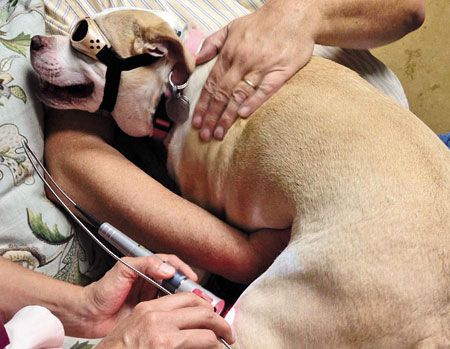Two practices shine light on laser therapy in the veterinary business model
Billing it as a standard of care is among the takeaways of success stories.
As any savvy veterinary practice owner knows, buying a new piece of equipment doesn't equal successful patient outcomes and a bump to the bottom line. After choosing a therapy-laser company, there's still a critical step-using a new piece of equipment enough to justify the investment and marketing it to new and existing clients.
That's where these two practices' approaches come in. See how the owners and team members made laser therapy profitable as a guide for the therapy laser you're underusing-or the one in your future.
Dr. Johnson saw a 3 percent revenue boost
Jennifer Johnson, VMD, CVPP, owner of Stoney Creek Veterinary Hospital in Morton, Pennsylvania, invested in a therapy laser five years ago. And the venture paid off- she's increased revenue by 3 percent (or $85,000 in profit from therapy laser services) in the past year alone.
She did it by adding laser therapy to every surgery as well as offering it to clients with other health issues from orthopedic problems to ear infections. Offering laser therapy for a variety of health issues early on gave Johnson more instances to prove its efficacy with proven results, she says.
At the same time, Dr. Johnson also examined the reasons behind clients' post-op calls. Before therapy laser, 30 percent of clients would call in or visit about minor healing issues. That has dropped to 14 percent. Her practice simply tracked the number of calls and the reason for the calls and analyzed those results. In comparison, there were less post-op calls after laser therapy was implemented.
Johnson's success brought in new clients, and existing clients didn't object to the laser therapy fee (it started at about $12 five years ago and now hovers around $15). Johnson added it as a line item on treatment plans and explains that it's part of the service. She gives every client an information sheet her practice created about laser therapy's benefits.

Fiona, a 9-year-old pocket pit bull suffering from spondylosis in her caudal lumbar spine as well as osteoarthritis in bilateral hips and stifles, receives laser therapy. In addition to using laser therapy for general surgeries, she also adds two weeks of laser therapy after each ACL surgery (one treatment every other day for two weeks) plus eight sessions of hour-long therapy after that. The package adds about $600 to the ACL procedure for a total cost of about $2,500. She also offers 20-minute laser therapy sessions for osteoarthritis patients.
Treating acute cases like cystitis and otitis can take two to three minutes and improve the patient's pain immediately. “You add $30 to the invoice and you get a happy client because you have a better outcome,” she says.
Johnson bought the therapy laser unit on a four-year payment plan for $30,000 but used her increased revenue to pay off the entire balance within the first year of her purchase.
Johnson offers several packages for laser therapy based on the patient's condition, such as $250 for six osteoarthritis treatments or $70 for three general laser treatments.
Another appeal of laser therapy is that technicians can do it, allowing for lower overhead and giving the veterinarian more time to see other patients. “I haven't actually touched the laser in over a year,” Johnson says.
Dr. Harper “shows, not tells” about the benefits
Annie Wells, laser therapy coordinator at Tuscan Ridge Animal Hospital in Wake Forest, North Carolina, says laser therapy is part of the standard of care at the one-year-old practice. However, Wells and practice owner Kelly Harper, DVM, came from another practice that didn't use its own laser as much.
“The applications for the use of the laser are virtually limitless, so when you approach the implementation of the use of the laser, the integration of the laser into my business from that standpoint, then the economics of it really just follows,” Harper says.

A wound progression shows a 12-year-old chocolate Labrador with granulomatous dermatitis.Like Dr. Jennifer Johnson in Pennsylvania, Dr. Harper says her clients don't decline the treatment. “I just lay it out as part of my treatment,” Dr. Harper says. “It's how you deliver it. If [the recommendation is] delivered with confidence, it just becomes accepted by the client and, in my opinion, it's good medicine. And when I practice good medicine, good business follows.”
Post-op laser therapy is built into the cost of spays and neuters at Tuscan Ridge, and clients don't see the charge. For other elective surgeries, clients see a separate line item of $35 to $40.

A pit bull receives laser treatment for post-op arthritis after a cruciate repair to her stifle.The practice also offers package deals. Clients with pets who have musculoskeletal issues often return for repeat treatments and receive a 10-session package for approximately $315.
Wells hosts tours that feature a presentation on laser therapy, and the practice's website promotes it and offers an informational video. She's created a binder of case studies with case descriptions and before-and-after photos. Anyone in the waiting room can flip through the binder or bring it into the exam room during a consultation.
Wells says the binder allows them to provide a client with evidence of success.
“They can see that the other owners are using it, as well,” she says. “The pictures, particularly on the wound healing, are quite remarkable.”
Rachael Zimlich is a freelance writer in Cleveland, Ohio. She formerly worked for dvm360 magazine.
Newsletter
From exam room tips to practice management insights, get trusted veterinary news delivered straight to your inbox—subscribe to dvm360.